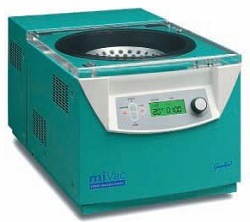THE REMOVAL of water and organic solvents from samples of DNA, RNA, and other biological specimens is a slightly more delicate task than the average laboratory evaporation procedure. Samples are typically of low volume and are heat-sensitive, and so may be damaged by some evaporation techniques

Genevac's miVac DNA is specifically for evaporating nucleic acids
Genevac says its miVac DNA delivers best-in-class evaporation performance, offering scientists everything needed in a compact benchtop unit. The device removes low volumes of water and organic solvents from multiple sample formats, including microplates, vials, tubes, and round bottom flasks.
A single control knob allows the user to ‘select and set’, and even new users can expect excellent results every time, the company claims.
More advanced users can access a number of special modes of operation, which can accelerate concentration procedures. With digital temperature control and short evaporation times, risk of heat damage is reduced.
Genevac says the quiet-running miVac DNA returns 100% of the sample every time, unlike centrifugal filters, with no consumable costs, making it useful in biology, research, and forensic laboratories.
